Abstract
The demand for susceptibility testing of anaerobes has increased, yet consensus as to procedure and interpretation in this area has not been achieved. While routine testing of anaerobic isolates is not needed, certain isolates in specific clinical settings should be tested. Also, laboratories may monitor their local antibiograms by doing periodic surveillance batch testing. The National Committee for Clinical Laboratory Standards has published a protocol of methods approved for susceptibility testing of anaerobic bacteria. Both agar and broth microdilution are included; however, the broth disk elution method is no longer approved by the National Committee for Clinical Laboratory Standards because of method-related interpretive errors. A number of newer methods are undergoing evaluation and seem promising. Clinicians and microbiologists reviewing susceptibility reports should be aware of sources of variability in the test results. Variables in susceptibility testing of anaerobes include the media and methods used, organisms chosen for testing, breakpoints chosen for interpretation, antibiotic, and determination of endpoint. Clustering of MICs around the breakpoint may lead to significant variability in test results. Adherence of testing laboratories to approved methods and careful descriptions of the method and the breakpoints used for interpretation would facilitate interlaboratory comparisons and allow problems of emerging resistance to be noted. A variety of resistance mechanisms occurs in anaerobic bacteria, including the production of beta-lactamase and other drug-inactivating enzymes, alteration of target proteins, and inability of the drug to penetrate the bacterial wall. Antimicrobial resistance patterns in the United States and abroad are described.
Full text
PDF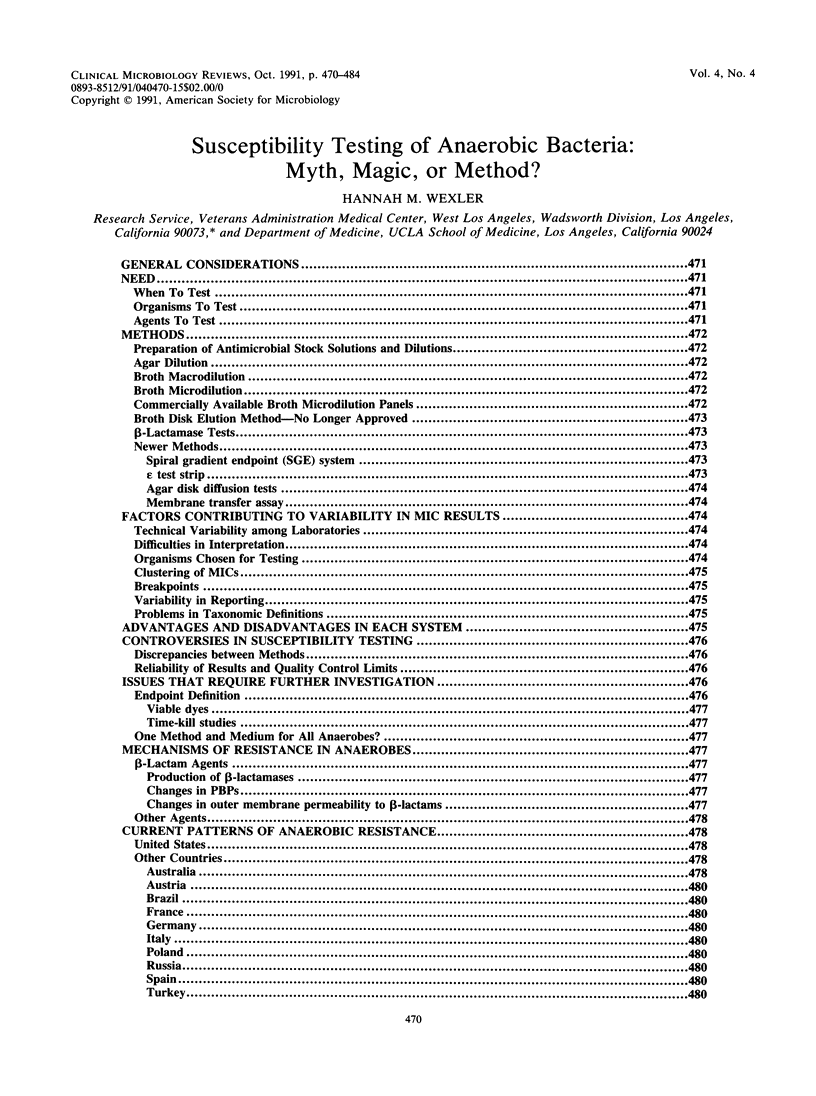
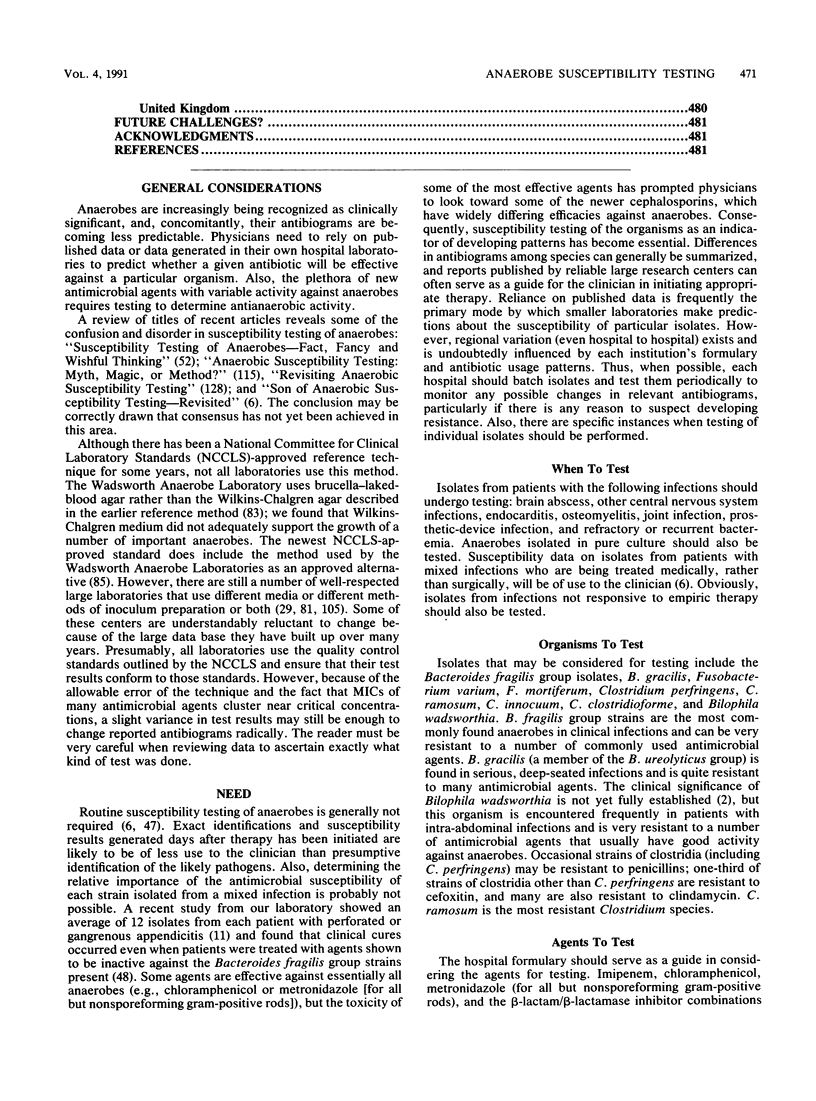
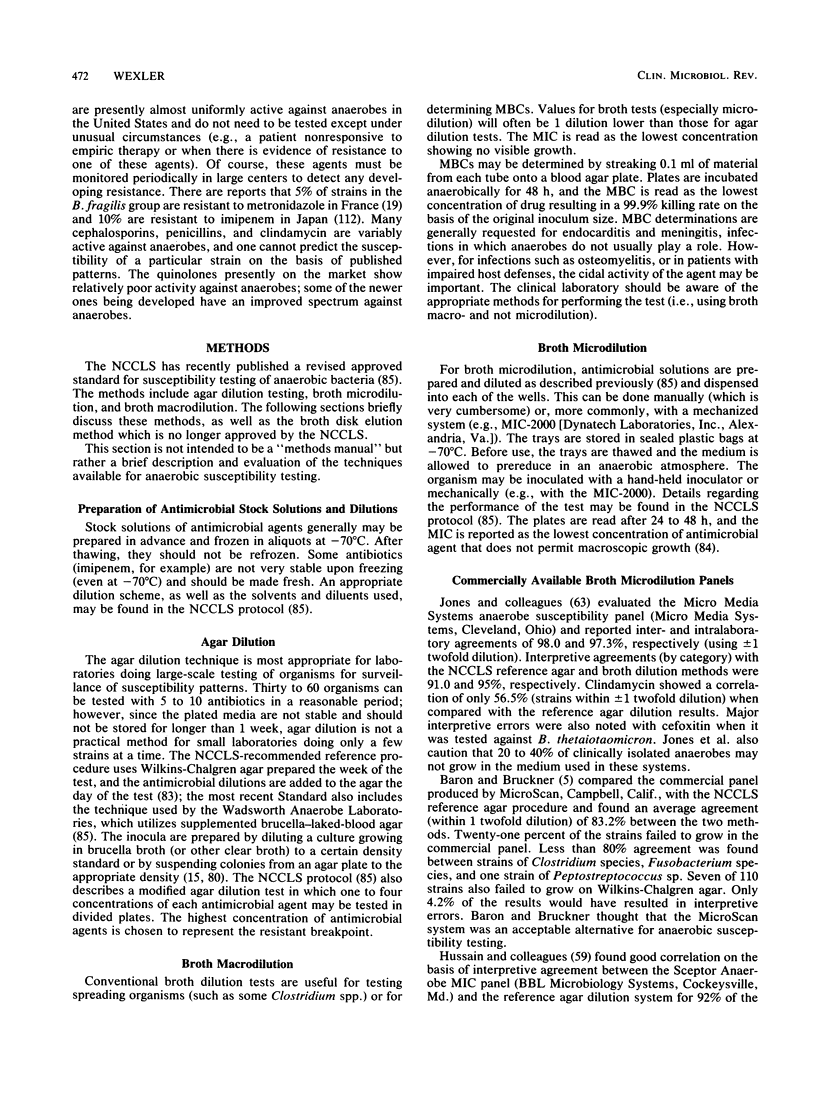
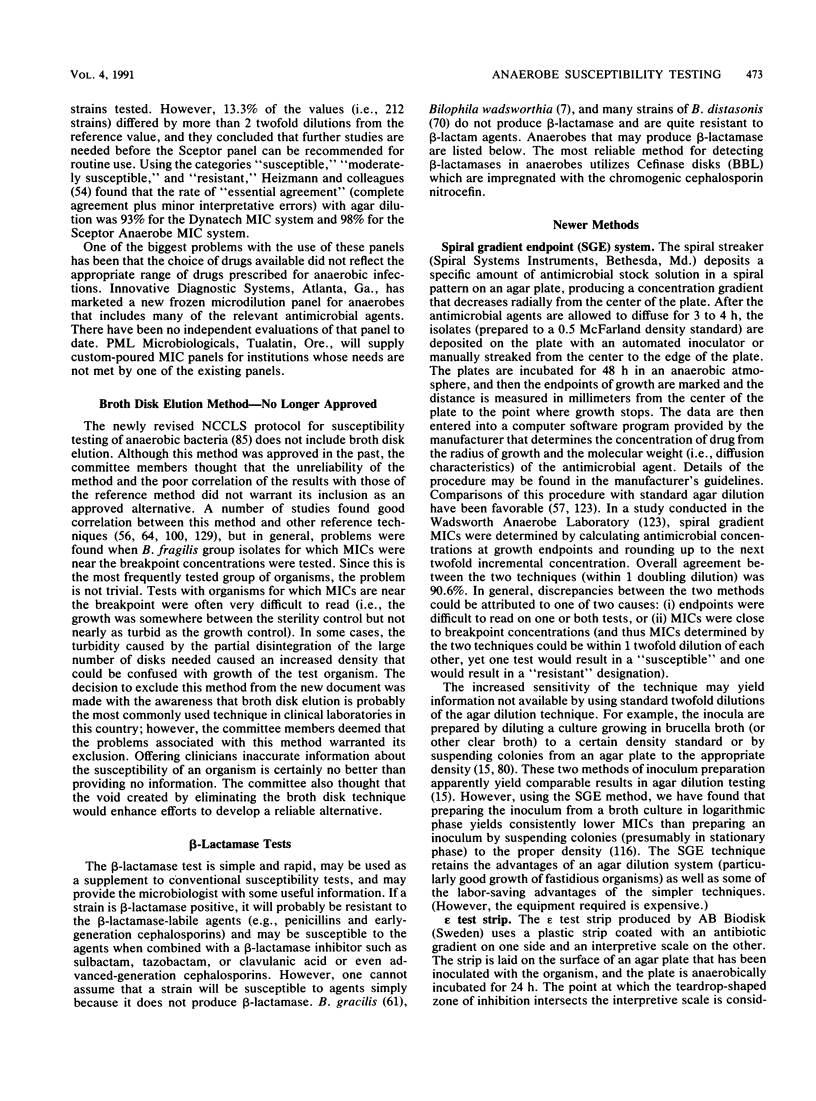
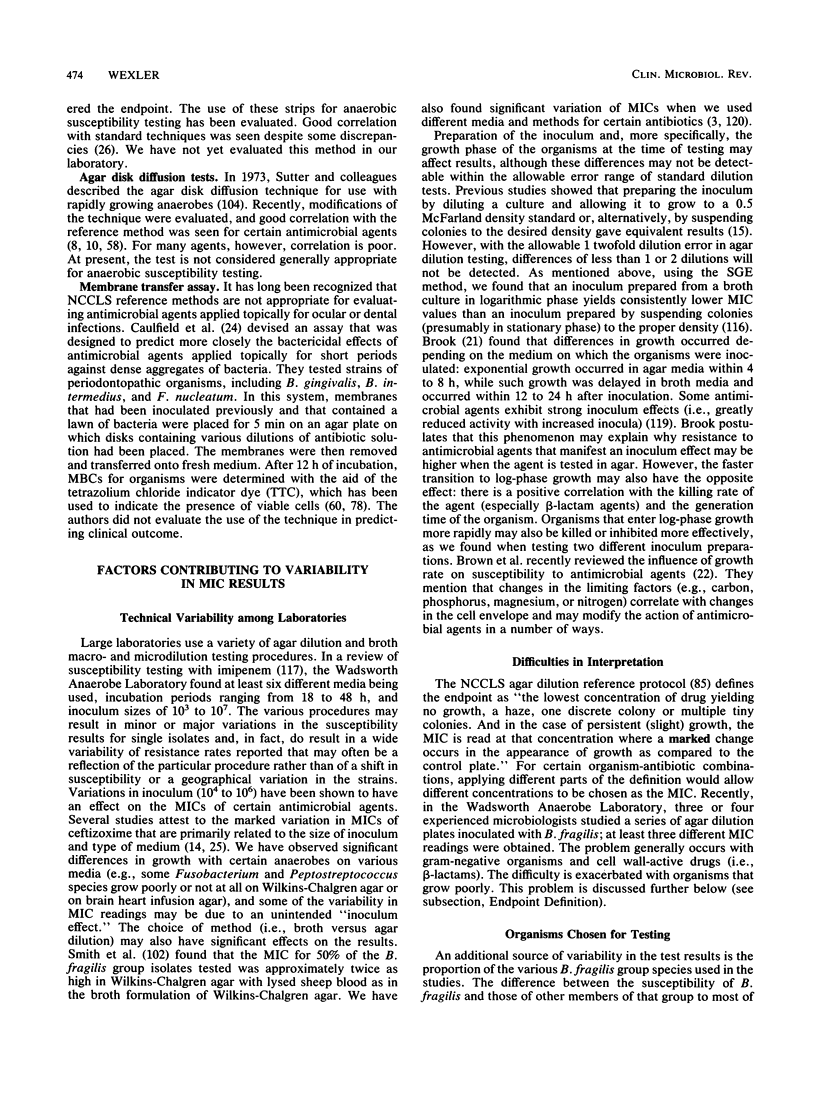
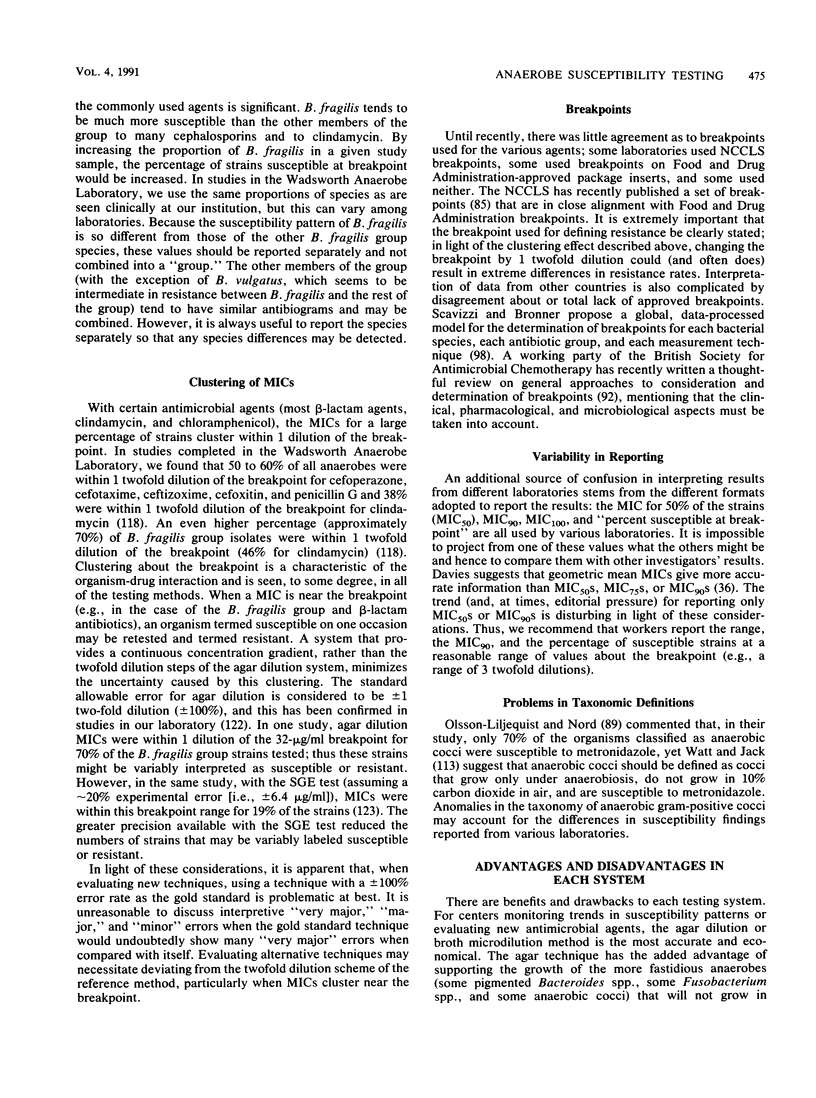
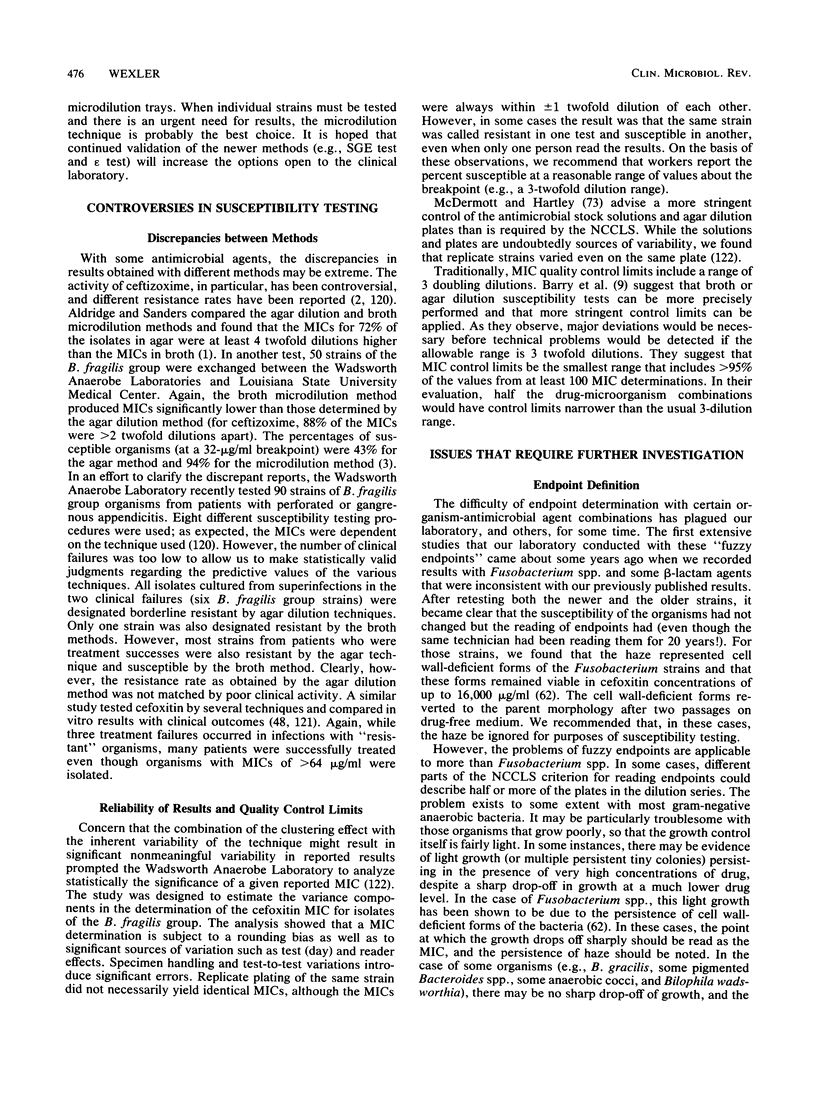
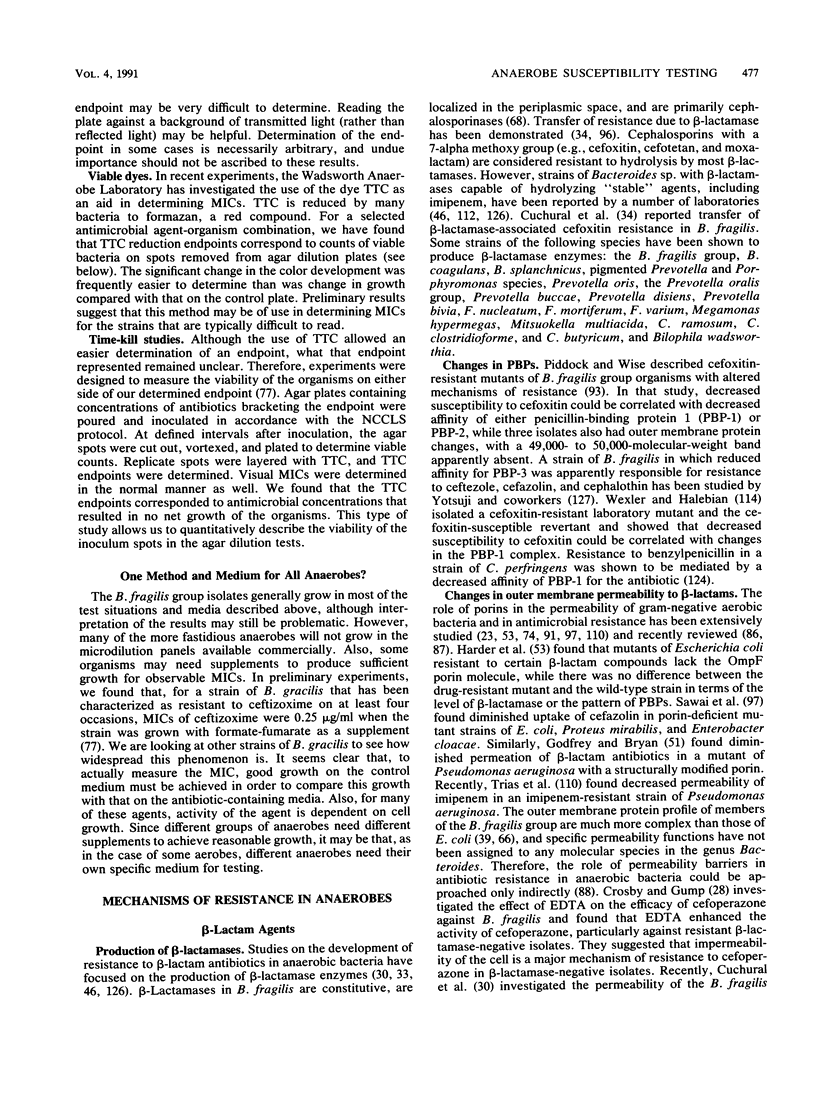
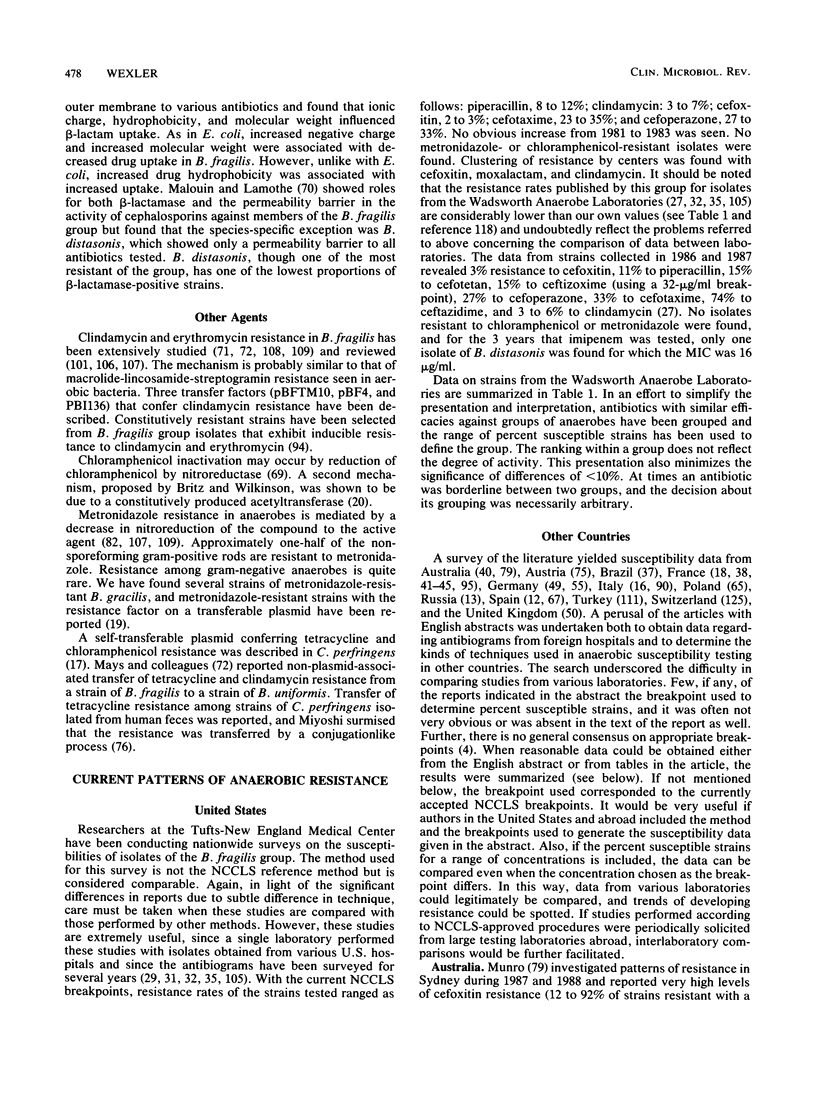
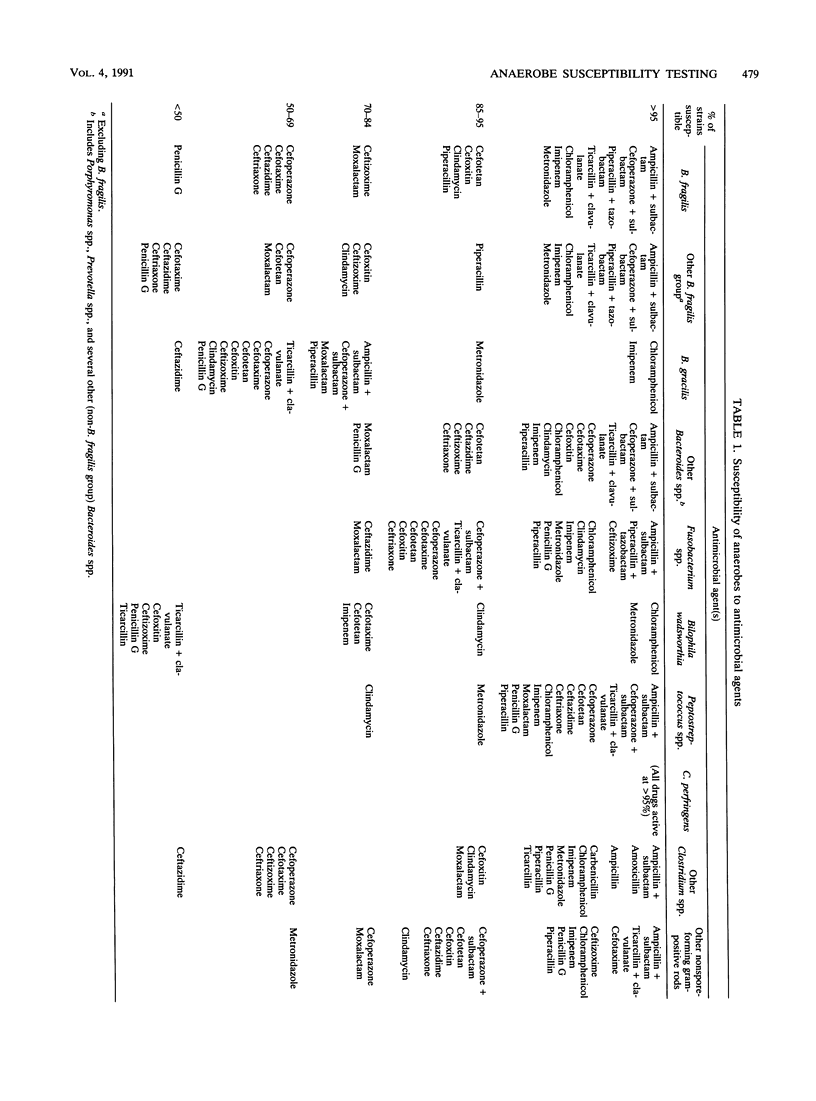
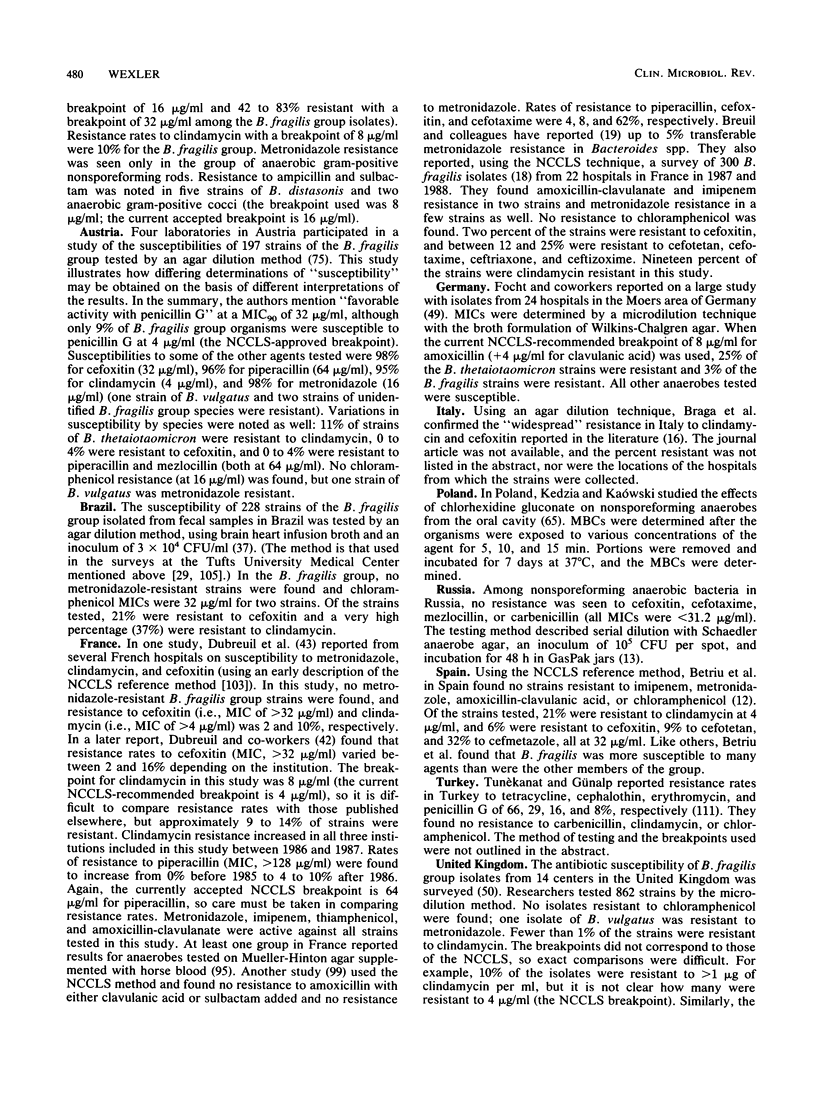
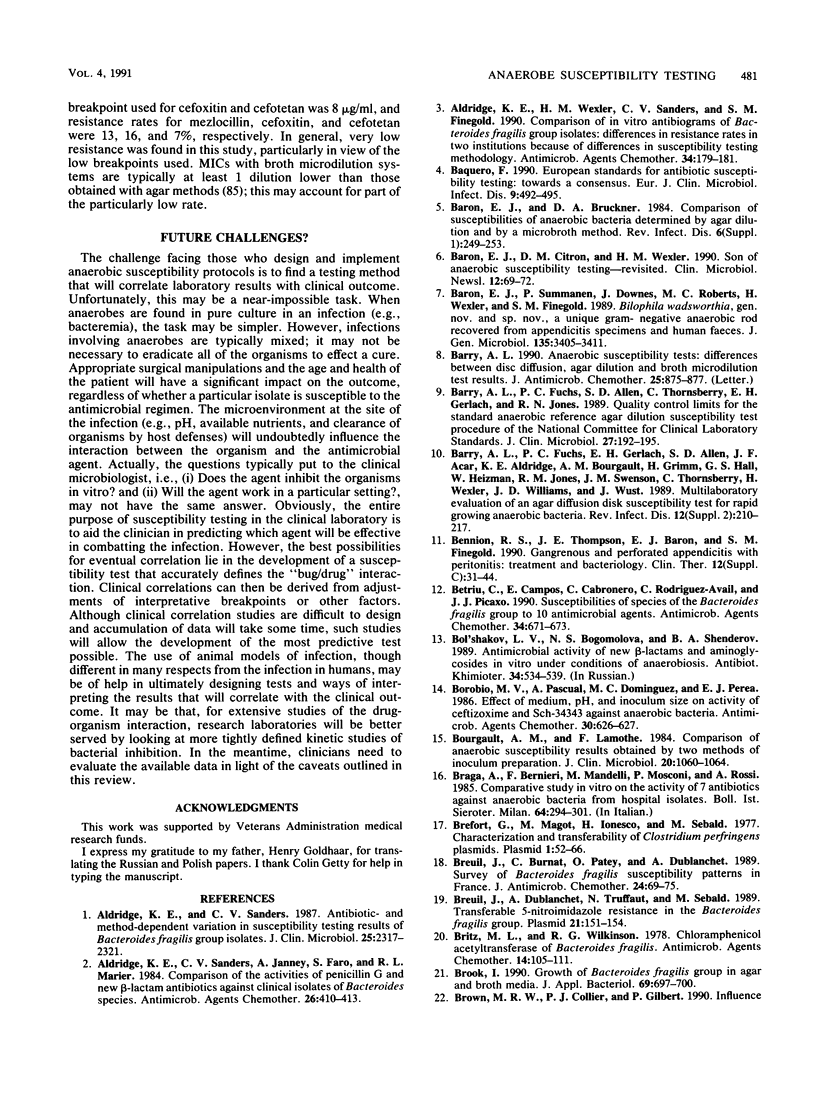
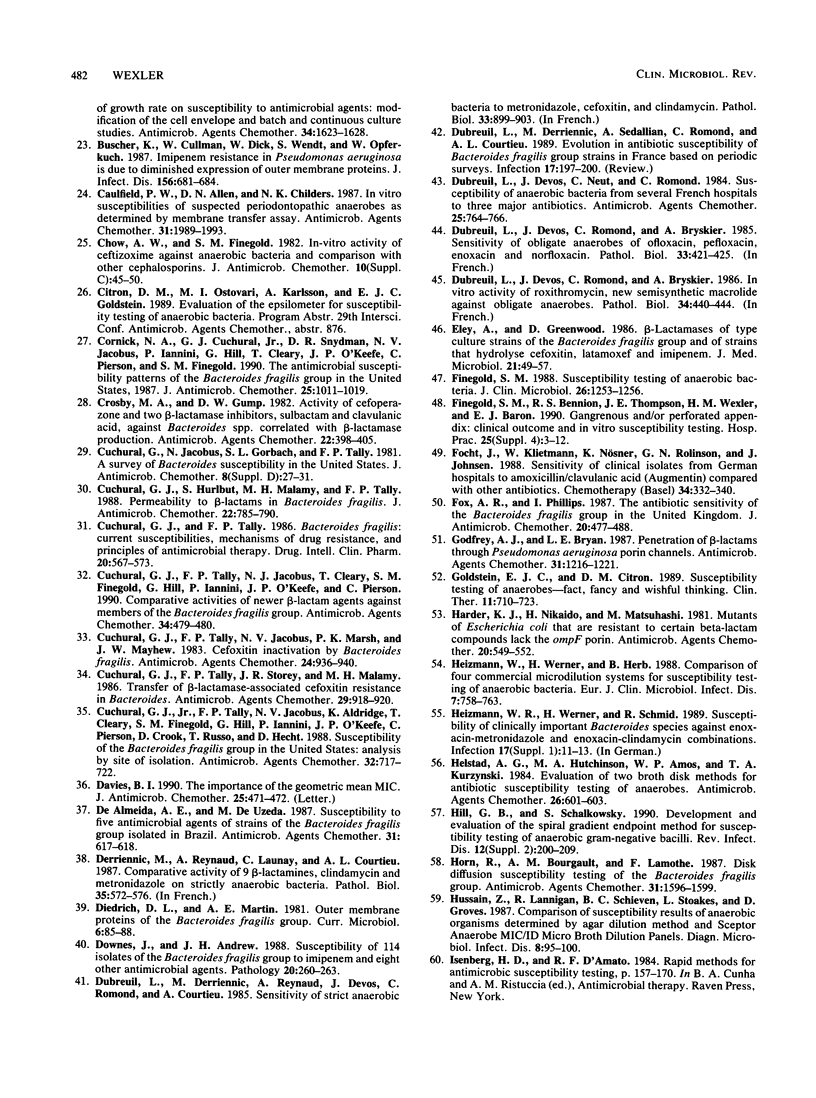
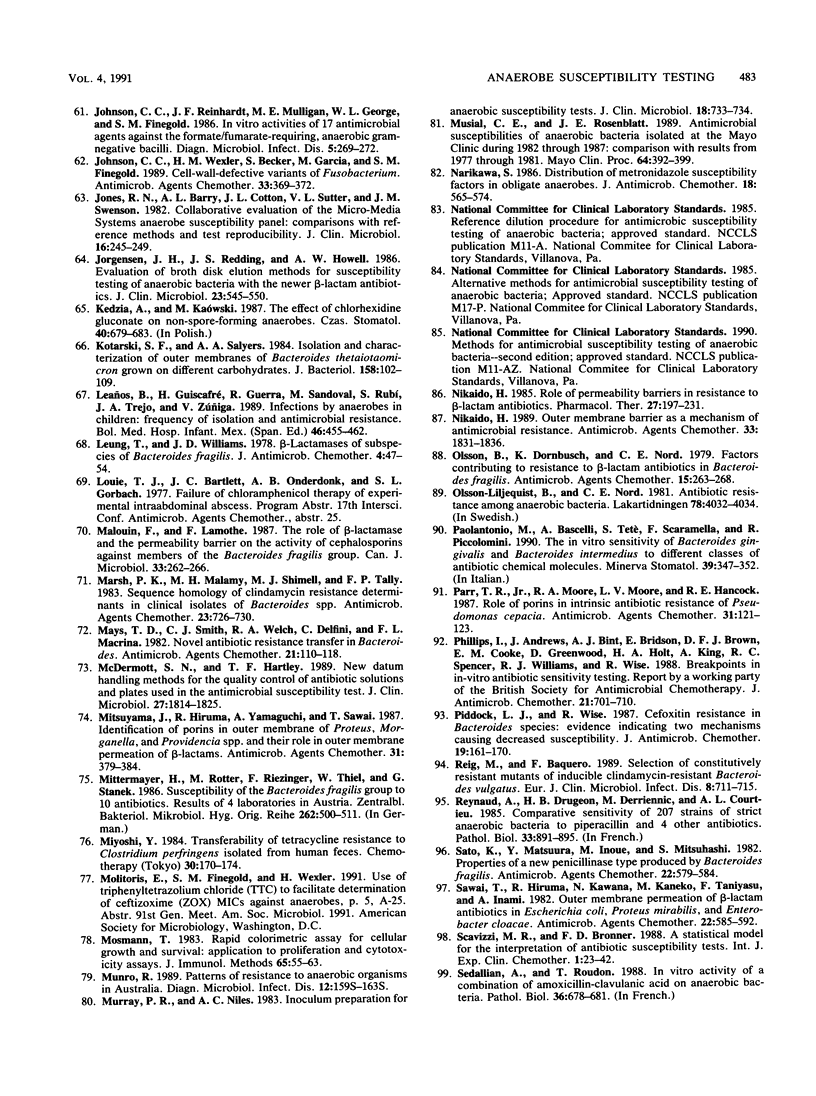
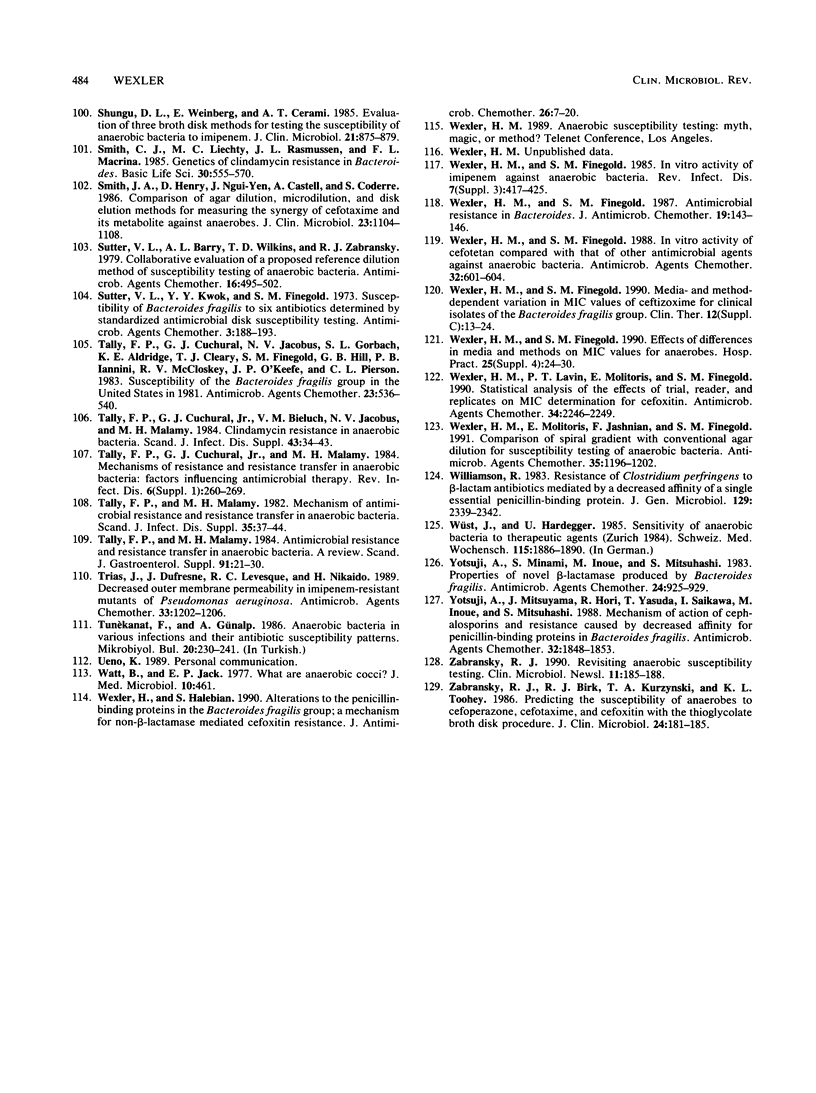
Selected References
These references are in PubMed. This may not be the complete list of references from this article.
- Aldridge K. E., Sanders C. V. Antibiotic- and method-dependent variation in susceptibility testing results of Bacteroides fragilis group isolates. J Clin Microbiol. 1987 Dec;25(12):2317–2321. doi: 10.1128/jcm.25.12.2317-2321.1987. [DOI] [PMC free article] [PubMed] [Google Scholar]
- Aldridge K. E., Sanders C. V., Janney A., Faro S., Marier R. L. Comparison of the activities of penicillin G and new beta-lactam antibiotics against clinical isolates of Bacteroides species. Antimicrob Agents Chemother. 1984 Sep;26(3):410–413. doi: 10.1128/aac.26.3.410. [DOI] [PMC free article] [PubMed] [Google Scholar]
- Aldridge K. E., Wexler H. M., Sanders C. V., Finegold S. M. Comparison of in vitro antibiograms of Bacteroides fragilis group isolates: differences in resistance rates in two institutions because of differences in susceptibility testing methodology. Antimicrob Agents Chemother. 1990 Jan;34(1):179–181. doi: 10.1128/aac.34.1.179. [DOI] [PMC free article] [PubMed] [Google Scholar]
- Baquero F. European standards for antibiotic susceptibility testing: towards a theoretical consensus. Eur J Clin Microbiol Infect Dis. 1990 Jul;9(7):492–495. doi: 10.1007/BF01964289. [DOI] [PubMed] [Google Scholar]
- Baron E. J., Summanen P., Downes J., Roberts M. C., Wexler H., Finegold S. M. Bilophila wadsworthia, gen. nov. and sp. nov., a unique gram-negative anaerobic rod recovered from appendicitis specimens and human faeces. J Gen Microbiol. 1989 Dec;135(12):3405–3411. doi: 10.1099/00221287-135-12-3405. [DOI] [PubMed] [Google Scholar]
- Barry A. L. Anaerobic susceptibility tests: differences between disc diffusion, agar dilution and broth microdilution test results. J Antimicrob Chemother. 1990 May;25(5):875–877. doi: 10.1093/jac/25.5.875. [DOI] [PubMed] [Google Scholar]
- Barry A. L., Fuchs P. C., Allen S. D., Thornsberry C., Gerlach E. H., Jones R. N. Quality control limits for the standard anaerobic reference agar dilution susceptibility test procedure of the National Committee for Clinical Laboratory Standards. J Clin Microbiol. 1989 Jan;27(1):192–195. doi: 10.1128/jcm.27.1.192-195.1989. [DOI] [PMC free article] [PubMed] [Google Scholar]
- Bennion R. S., Thompson J. E., Baron E. J., Finegold S. M. Gangrenous and perforated appendicitis with peritonitis: treatment and bacteriology. Clin Ther. 1990;12 (Suppl 100):31–44. [PubMed] [Google Scholar]
- Betriu C., Campos E., Cabronero C., Rodriguez-Avial C., Picazo J. J. Susceptibilities of species of the Bacteroides fragilis group to 10 antimicrobial agents. Antimicrob Agents Chemother. 1990 Apr;34(4):671–673. doi: 10.1128/aac.34.4.671. [DOI] [PMC free article] [PubMed] [Google Scholar]
- Borobio M. V., Pascual A., Dominguez M. C., Perea E. J. Effect of medium, pH, and inoculum size on activity of ceftizoxime and Sch-34343 against anaerobic bacteria. Antimicrob Agents Chemother. 1986 Oct;30(4):626–627. doi: 10.1128/aac.30.4.626. [DOI] [PMC free article] [PubMed] [Google Scholar]
- Bourgault A. M., Lamothe F. Comparison of anaerobic susceptibility results obtained by two methods of inoculum preparation. J Clin Microbiol. 1984 Dec;20(6):1060–1064. doi: 10.1128/jcm.20.6.1060-1064.1984. [DOI] [PMC free article] [PubMed] [Google Scholar]
- Braga A., Bernieri F., Mandelli M., Mosconi P., Rossi A. Studio comparativo in vitro sull' attività di sette antibiotici nei confronti di batteri anaerobi di isolamento ospedaliero. Boll Ist Sieroter Milan. 1985;64(4):294–301. [PubMed] [Google Scholar]
- Breakpoints in in-vitro antibiotic sensitivity testing. Report by a working party of the British Society for Antimicrobial Chemotherapy. J Antimicrob Chemother. 1988 Jun;21(6):701–710. [PubMed] [Google Scholar]
- Brefort G., Magot M., Ionesco H., Sebald M. Characterization and transferability of Clostridium perfringens plasmids. Plasmid. 1977 Nov;1(1):52–66. doi: 10.1016/0147-619x(77)90008-7. [DOI] [PubMed] [Google Scholar]
- Breuil J., Burnat C., Patey O., Dublanchet A. Survey of Bacteroides fragilis susceptibility patterns in France. J Antimicrob Chemother. 1989 Jul;24(1):69–75. doi: 10.1093/jac/24.1.69. [DOI] [PubMed] [Google Scholar]
- Breuil J., Dublanchet A., Truffaut N., Sebald M. Transferable 5-nitroimidazole resistance in the Bacteroides fragilis group. Plasmid. 1989 Mar;21(2):151–154. doi: 10.1016/0147-619x(89)90060-7. [DOI] [PubMed] [Google Scholar]
- Britz M. L., Wilkinson R. G. Chloramphenicol acetyltransferase of Bacteroides fragilis. Antimicrob Agents Chemother. 1978 Jul;14(1):105–111. doi: 10.1128/aac.14.1.105. [DOI] [PMC free article] [PubMed] [Google Scholar]
- Brook I. Growth of Bacteroides fragilis group in agar and broth media. J Appl Bacteriol. 1990 Nov;69(5):697–700. doi: 10.1111/j.1365-2672.1990.tb01565.x. [DOI] [PubMed] [Google Scholar]
- Büscher K. H., Cullmann W., Dick W., Wendt S., Opferkuch W. Imipenem resistance in Pseudomonas aeruginosa is due to diminished expression of outer membrane proteins. J Infect Dis. 1987 Oct;156(4):681–684. doi: 10.1093/infdis/156.4.681. [DOI] [PubMed] [Google Scholar]
- Caufield P. W., Allen D. N., Childers N. K. In vitro susceptibilities of suspected periodontopathic anaerobes as determined by membrane transfer assay. Antimicrob Agents Chemother. 1987 Dec;31(12):1989–1993. doi: 10.1128/aac.31.12.1989. [DOI] [PMC free article] [PubMed] [Google Scholar]
- Chow A. W., Finegold S. M. In-vitro activity of ceftizoxime against anaerobic bacteria and comparison with other cephalosporins. J Antimicrob Chemother. 1982 Nov;10 (Suppl 100):45–50. doi: 10.1093/jac/10.suppl_c.45. [DOI] [PubMed] [Google Scholar]
- Cornick N. A., Cuchural G. J., Jr, Snydman D. R., Jacobus N. V., Iannini P., Hill G., Cleary T., O'Keefe J. P., Pierson C., Finegold S. M. The antimicrobial susceptibility patterns of the Bacteroides fragilis group in the United States, 1987. J Antimicrob Chemother. 1990 Jun;25(6):1011–1019. doi: 10.1093/jac/25.6.1011. [DOI] [PubMed] [Google Scholar]
- Crosby M. A., Gump D. W. Activity of cefoperazone and two beta-lactamase inhibitors, sulbactam and clavulanic acid, against Bacteroides spp. correlated with beta-lactamase production. Antimicrob Agents Chemother. 1982 Sep;22(3):398–405. doi: 10.1128/aac.22.3.398. [DOI] [PMC free article] [PubMed] [Google Scholar]
- Cuchural G. J., Hurlbut S., Malamy M. H., Tally F. P. Permeability to beta-lactams in Bacteroides fragilis. J Antimicrob Chemother. 1988 Dec;22(6):785–790. doi: 10.1093/jac/22.6.785. [DOI] [PubMed] [Google Scholar]
- Cuchural G. J., Jr, Tally F. P. Bacteroides fragilis: current susceptibilities, mechanisms of drug resistance, and principles of antimicrobial therapy. Drug Intell Clin Pharm. 1986 Jul-Aug;20(7-8):567–573. doi: 10.1177/106002808602000712. [DOI] [PubMed] [Google Scholar]
- Cuchural G. J., Jr, Tally F. P., Jacobus N. V., Aldridge K., Cleary T., Finegold S. M., Hill G., Iannini P., O'Keefe J. P., Pierson C. Susceptibility of the Bacteroides fragilis group in the United States: analysis by site of isolation. Antimicrob Agents Chemother. 1988 May;32(5):717–722. doi: 10.1128/aac.32.5.717. [DOI] [PMC free article] [PubMed] [Google Scholar]
- Cuchural G. J., Jr, Tally F. P., Jacobus N. V., Cleary T., Finegold S. M., Hill G., Iannini P., O'Keefe J. P., Pierson C. Comparative activities of newer beta-lactam agents against members of the Bacteroides fragilis group. Antimicrob Agents Chemother. 1990 Mar;34(3):479–480. doi: 10.1128/aac.34.3.479. [DOI] [PMC free article] [PubMed] [Google Scholar]
- Cuchural G. J., Jr, Tally F. P., Jacobus N. V., Marsh P. K., Mayhew J. W. Cefoxitin inactivation by Bacteroides fragilis. Antimicrob Agents Chemother. 1983 Dec;24(6):936–940. doi: 10.1128/aac.24.6.936. [DOI] [PMC free article] [PubMed] [Google Scholar]
- Cuchural G. J., Jr, Tally F. P., Storey J. R., Malamy M. H. Transfer of beta-lactamase-associated cefoxitin resistance in Bacteroides fragilis. Antimicrob Agents Chemother. 1986 May;29(5):918–920. doi: 10.1128/aac.29.5.918. [DOI] [PMC free article] [PubMed] [Google Scholar]
- Cuchural G., Jacobus N., Gorbach S. L., Tally F. P. A survey of Bacteroides susceptibility in the United States. J Antimicrob Chemother. 1981 Dec;8 (Suppl 500):27–31. doi: 10.1093/jac/8.suppl_d.27. [DOI] [PubMed] [Google Scholar]
- Davies B. I. The importance of the geometric mean MIC. J Antimicrob Chemother. 1990 Mar;25(3):471–472. doi: 10.1093/jac/25.3.471. [DOI] [PubMed] [Google Scholar]
- De Almeida A. E., De Uzeda M. Susceptibility to five antimicrobial agents of strains of the Bacteroides fragilis group isolated in Brazil. Antimicrob Agents Chemother. 1987 Apr;31(4):617–618. doi: 10.1128/aac.31.4.617. [DOI] [PMC free article] [PubMed] [Google Scholar]
- Downes J., Andrew J. H. Susceptibility of 114 isolates of the Bacteroides fragilis group to imipenem and eight other antimicrobial agents. Pathology. 1988 Jul;20(3):260–263. doi: 10.3109/00313028809059504. [DOI] [PubMed] [Google Scholar]
- Dubreuil L., Derriennic M., Reynaud A., Devos J., Romond C., Courtieu A. Sensibilité des anaérobies stricts au métronidazole, à la céfoxitine et à la clindamycine. Pathol Biol (Paris) 1985 Nov;33(9):899–903. [PubMed] [Google Scholar]
- Dubreuil L., Derriennic M., Sedallian A., Romond C., Courtieu A. L. Evolution in antibiotic susceptibility of Bacteroides fragilis group strains in France based on periodic surveys. Infection. 1989 May-Jun;17(3):197–200. doi: 10.1007/BF01644030. [DOI] [PubMed] [Google Scholar]
- Dubreuil L., Devos J., Neut C., Romond C. Susceptibility of anaerobic bacteria from several French hospitals to three major antibiotics. Antimicrob Agents Chemother. 1984 Jun;25(6):764–766. doi: 10.1128/aac.25.6.764. [DOI] [PMC free article] [PubMed] [Google Scholar]
- Dubreuil L., Devos J., Romond C., Bryskier A. Activité in vitro de la roxithromycine, nouveau macrolide semi-synthétique envers les anaérobies stricts. Pathol Biol (Paris) 1986 May;34(5):440–444. [PubMed] [Google Scholar]
- Eley A., Greenwood D. Beta-lactamases of type culture strains of the Bacteroides fragilis group and of strains that hydrolyse cefoxitin, latamoxef and imipenem. J Med Microbiol. 1986 Feb;21(1):49–57. doi: 10.1099/00222615-21-1-49. [DOI] [PubMed] [Google Scholar]
- Finegold S. M., Bennion R. S., Thompson J. E., Wexler H. M., Baron E. J. Gangrenous and/or perforated appendix: clinical outcome and in vitro susceptibility testing. Hosp Pract (Off Ed) 1990 Oct;25 (Suppl 4):3–12. doi: 10.1080/21548331.1990.11704110. [DOI] [PubMed] [Google Scholar]
- Finegold S. M. Susceptibility testing of anaerobic bacteria. J Clin Microbiol. 1988 Jul;26(7):1253–1256. doi: 10.1128/jcm.26.7.1253-1256.1988. [DOI] [PMC free article] [PubMed] [Google Scholar]
- Focht J., Klietmann W., Nösner K., Rolinson G. N., Johnsen J. Sensitivity of clinical isolates from German hospitals to amoxicillin/clavulanic acid (Augmentin) compared with other antibiotics. Chemotherapy. 1988;34(4):332–340. doi: 10.1159/000238588. [DOI] [PubMed] [Google Scholar]
- Fox A. R., Phillips I. The antibiotic sensitivity of the Bacteroides fragilis group in the United Kingdom. J Antimicrob Chemother. 1987 Oct;20(4):477–488. doi: 10.1093/jac/20.4.477. [DOI] [PubMed] [Google Scholar]
- Godfrey A. J., Bryan L. E. Penetration of beta-lactams through Pseudomonas aeruginosa porin channels. Antimicrob Agents Chemother. 1987 Aug;31(8):1216–1221. doi: 10.1128/aac.31.8.1216. [DOI] [PMC free article] [PubMed] [Google Scholar]
- Goldstein E. J., Citron D. M. Susceptibility testing of anaerobes--fact, fancy, and wishful thinking. Clin Ther. 1989 Nov-Dec;11(6):710–723. [PubMed] [Google Scholar]
- Harder K. J., Nikaido H., Matsuhashi M. Mutants of Escherichia coli that are resistant to certain beta-lactam compounds lack the ompF porin. Antimicrob Agents Chemother. 1981 Oct;20(4):549–552. doi: 10.1128/aac.20.4.549. [DOI] [PMC free article] [PubMed] [Google Scholar]
- Heizmann W., Werner H., Herb B. Comparison of four commercial microdilution systems for susceptibility testing of anaerobic bacteria. Eur J Clin Microbiol Infect Dis. 1988 Dec;7(6):758–763. doi: 10.1007/BF01975043. [DOI] [PubMed] [Google Scholar]
- Helstad A. G., Hutchinson M. A., Amos W. P., Kurzynski T. A. Evaluation of two broth disk methods for antibiotic susceptibility testing of anaerobes. Antimicrob Agents Chemother. 1984 Oct;26(4):601–603. doi: 10.1128/aac.26.4.601. [DOI] [PMC free article] [PubMed] [Google Scholar]
- Horn R., Bourgault A. M., Lamothe F. Disk diffusion susceptibility testing of the Bacteroides fragilis group. Antimicrob Agents Chemother. 1987 Oct;31(10):1596–1599. doi: 10.1128/aac.31.10.1596. [DOI] [PMC free article] [PubMed] [Google Scholar]
- Hussain Z., Lannigan R., Schieven B. C., Stoakes L., Groves D. Comparison of susceptibility results of anaerobic organisms determined by agar dilution method and Sceptor Anaerobe MIC/ID Micro Broth Dilution Panels. Diagn Microbiol Infect Dis. 1987 Oct;8(2):95–100. doi: 10.1016/0732-8893(87)90155-6. [DOI] [PubMed] [Google Scholar]
- Johnson C. C., Reinhardt J. F., Mulligan M. E., George W. L., Finegold S. M. In vitro activities of 17 antimicrobial agents against the formate/fumarate-requiring, anaerobic gram-negative bacilli. Diagn Microbiol Infect Dis. 1986 Sep;5(3):269–272. doi: 10.1016/0732-8893(86)90011-8. [DOI] [PubMed] [Google Scholar]
- Johnson C. C., Wexler H. M., Becker S., Garcia M., Finegold S. M. Cell-wall-defective variants of Fusobacterium. Antimicrob Agents Chemother. 1989 Mar;33(3):369–372. doi: 10.1128/aac.33.3.369. [DOI] [PMC free article] [PubMed] [Google Scholar]
- Jones R. N., Barry A. L., Cotton J. L., Sutter V. L., Swenson J. M. Collaborative evaluation of the micro-media systems anaerobe susceptibility panel: comparisons with reference methods and test reproducibility. J Clin Microbiol. 1982 Aug;16(2):245–249. doi: 10.1128/jcm.16.2.245-249.1982. [DOI] [PMC free article] [PubMed] [Google Scholar]
- Jorgensen J. H., Redding J. S., Howell A. W. Evaluation of broth disk elution methods for susceptibility testing of anaerobic bacteria with the newer beta-lactam antibiotics. J Clin Microbiol. 1986 Mar;23(3):545–550. doi: 10.1128/jcm.23.3.545-550.1986. [DOI] [PMC free article] [PubMed] [Google Scholar]
- Kedzia A., Kałowski M. Działanie glukonianu chloroheksydyny na nieprzetrwalnikujace bakterie beztlenowe. Czas Stomatol. 1987 Oct;40(10):679–683. [PubMed] [Google Scholar]
- Kotarski S. F., Salyers A. A. Isolation and characterization of outer membranes of Bacteroides thetaiotaomicron grown on different carbohydrates. J Bacteriol. 1984 Apr;158(1):102–109. doi: 10.1128/jb.158.1.102-109.1984. [DOI] [PMC free article] [PubMed] [Google Scholar]
- Leaños B., Guiscafré H., Guerra R., Sandoval M., Rubí S., Trejo J. A., Zúiga V. Infecciones por anaerobios en niños: frecuencia de aislamiento y resistencia antimicrobiana. Bol Med Hosp Infant Mex. 1989 Jul;46(7):455–462. [PubMed] [Google Scholar]
- Leung T., Williams J. D. beta-Lactamases of subspecies of Bacteroides fragilis. J Antimicrob Chemother. 1978 Jul;4(B):47–54. doi: 10.1093/jac/4.suppl_b.47. [DOI] [PubMed] [Google Scholar]
- Malouin F., Lamothe F. The role of beta-lactamase and the permeability barrier on the activity of cephalosporins against members of the Bacteroides fragilis group. Can J Microbiol. 1987 Mar;33(3):262–266. doi: 10.1139/m87-044. [DOI] [PubMed] [Google Scholar]
- Marsh P. K., Malamy M. H., Shimell M. J., Tally F. P. Sequence homology of clindamycin resistance determinants in clinical isolates of Bacteroides spp. Antimicrob Agents Chemother. 1983 May;23(5):726–730. doi: 10.1128/aac.23.5.726. [DOI] [PMC free article] [PubMed] [Google Scholar]
- Mays T. D., Smith C. J., Welch R. A., Delfini C., Macrina F. L. Novel antibiotic resistance transfer in Bacteroides. Antimicrob Agents Chemother. 1982 Jan;21(1):110–118. doi: 10.1128/aac.21.1.110. [DOI] [PMC free article] [PubMed] [Google Scholar]
- McDermott S. N., Hartley T. F. New datum handling methods for the quality control of antibiotic solutions and plates used in the antimicrobial susceptibility test. J Clin Microbiol. 1989 Aug;27(8):1814–1825. doi: 10.1128/jcm.27.8.1814-1825.1989. [DOI] [PMC free article] [PubMed] [Google Scholar]
- Mitsuyama J., Hiruma R., Yamaguchi A., Sawai T. Identification of porins in outer membrane of Proteus, Morganella, and Providencia spp. and their role in outer membrane permeation of beta-lactams. Antimicrob Agents Chemother. 1987 Mar;31(3):379–384. doi: 10.1128/aac.31.3.379. [DOI] [PMC free article] [PubMed] [Google Scholar]
- Mittermayer H., Rotter M., Riezinger F., Thiel W., Stanek G. Die Empfindlichkeit der Bacteroides-fragilis-Gruppe gegenüber 10 Antibiotika. Ergebnisse aus vier Laboratorien in Osterreich. Zentralbl Bakteriol Mikrobiol Hyg A. 1986 Nov;262(4):500–511. [PubMed] [Google Scholar]
- Miyoshi Y. Transferability of tetracycline resistance to Clostridium perfringens isolated from human feces. Chemotherapy. 1984;30(3):170–174. doi: 10.1159/000238264. [DOI] [PubMed] [Google Scholar]
- Mosmann T. Rapid colorimetric assay for cellular growth and survival: application to proliferation and cytotoxicity assays. J Immunol Methods. 1983 Dec 16;65(1-2):55–63. doi: 10.1016/0022-1759(83)90303-4. [DOI] [PubMed] [Google Scholar]
- Munro R. Patterns of resistance to anaerobic organisms in Australia. Diagn Microbiol Infect Dis. 1989 Jul-Aug;12(4 Suppl):159S–163S. doi: 10.1016/0732-8893(89)90129-6. [DOI] [PubMed] [Google Scholar]
- Murray P. R., Niles A. C. Inoculum preparation for anaerobic susceptibility tests. J Clin Microbiol. 1983 Sep;18(3):733–734. doi: 10.1128/jcm.18.3.733-734.1983. [DOI] [PMC free article] [PubMed] [Google Scholar]
- Musial C. E., Rosenblatt J. E. Antimicrobial susceptibilities of anaerobic bacteria isolated at the Mayo Clinic during 1982 through 1987: comparison with results from 1977 through 1981. Mayo Clin Proc. 1989 Apr;64(4):392–399. doi: 10.1016/s0025-6196(12)65727-9. [DOI] [PubMed] [Google Scholar]
- Narikawa S. Distribution of metronidazole susceptibility factors in obligate anaerobes. J Antimicrob Chemother. 1986 Nov;18(5):565–574. doi: 10.1093/jac/18.5.565. [DOI] [PubMed] [Google Scholar]
- Nikaido H. Outer membrane barrier as a mechanism of antimicrobial resistance. Antimicrob Agents Chemother. 1989 Nov;33(11):1831–1836. doi: 10.1128/aac.33.11.1831. [DOI] [PMC free article] [PubMed] [Google Scholar]
- Nikaido H. Role of permeability barriers in resistance to beta-lactam antibiotics. Pharmacol Ther. 1985;27(2):197–231. doi: 10.1016/0163-7258(85)90069-5. [DOI] [PubMed] [Google Scholar]
- Olsson-Liljequist B., Nord C. E. Antibiotikaresistens hos anaeroba bakterier. Lakartidningen. 1981 Nov 4;78(45):4032–4034. [PubMed] [Google Scholar]
- Olsson B., Dornbusch K., Nord C. E. Factors contributing to resistance to beta-lactam antibiotics in Bacteroides fragilis. Antimicrob Agents Chemother. 1979 Feb;15(2):263–268. doi: 10.1128/aac.15.2.263. [DOI] [PMC free article] [PubMed] [Google Scholar]
- Paolantonio M., Bascelli A., Tetè S., Scaramella F., Piccolomini R. Sensibilitá "in vitro" di Bacteroides gingivalis e Bacteroides intermedius a diverse classi di molecole chemio-antibiotiche. Minerva Stomatol. 1990 May;39(5):347–352. [PubMed] [Google Scholar]
- Parr T. R., Jr, Moore R. A., Moore L. V., Hancock R. E. Role of porins in intrinsic antibiotic resistance of Pseudomonas cepacia. Antimicrob Agents Chemother. 1987 Jan;31(1):121–123. doi: 10.1128/aac.31.1.121. [DOI] [PMC free article] [PubMed] [Google Scholar]
- Piddock L. J., Wise R. Cefoxitin resistance in Bacteroides species: evidence indicating two mechanisms causing decreased susceptibility. J Antimicrob Chemother. 1987 Feb;19(2):161–170. doi: 10.1093/jac/19.2.161. [DOI] [PubMed] [Google Scholar]
- Reig M., Baquero F. Selection of constitutively resistant mutants of inducible clindamycin-resistant Bacteroides vulgatus. Eur J Clin Microbiol Infect Dis. 1989 Aug;8(8):711–715. doi: 10.1007/BF01963757. [DOI] [PubMed] [Google Scholar]
- Sato K., Matsuura Y., Inoue M., Mitsuhashi S. Properties of a new penicillinase type produced by Bacteroides fragilis. Antimicrob Agents Chemother. 1982 Oct;22(4):579–584. doi: 10.1128/aac.22.4.579. [DOI] [PMC free article] [PubMed] [Google Scholar]
- Sawai T., Hiruma R., Kawana N., Kaneko M., Taniyasu F., Inami A. Outer membrane permeation of beta-lactam antibiotics in Escherichia coli, Proteus mirabilis, and Enterobacter cloacae. Antimicrob Agents Chemother. 1982 Oct;22(4):585–592. doi: 10.1128/aac.22.4.585. [DOI] [PMC free article] [PubMed] [Google Scholar]
- Shungu D. L., Weinberg E., Cerami A. T. Evaluation of three broth disk methods for testing the susceptibility of anaerobic bacteria to imipenem. J Clin Microbiol. 1985 Jun;21(6):875–879. doi: 10.1128/jcm.21.6.875-879.1985. [DOI] [PMC free article] [PubMed] [Google Scholar]
- Smith C. J., Liechty M. C., Rasmussen J. L., Macrina F. L. Genetics of clindamycin resistance in Bacteroides. Basic Life Sci. 1985;30:555–570. doi: 10.1007/978-1-4613-2447-8_39. [DOI] [PubMed] [Google Scholar]
- Smith J. A., Henry D., Ngui-Yen J., Castell A., Coderre S. Comparison of agar dilution, microdilution, and disk elution methods for measuring the synergy of cefotaxime and its metabolite against anaerobes. J Clin Microbiol. 1986 Jun;23(6):1104–1108. doi: 10.1128/jcm.23.6.1104-1108.1986. [DOI] [PMC free article] [PubMed] [Google Scholar]
- Sutter V. L., Barry A. L., Wilkins T. D., Zabransky R. J. Collaborative evaluation of a proposed reference dilution method of susceptibility testing of anaerobic bacteria. Antimicrob Agents Chemother. 1979 Oct;16(4):495–502. doi: 10.1128/aac.16.4.495. [DOI] [PMC free article] [PubMed] [Google Scholar]
- Sutter V. L., Kwok Y., Finegold S. M. Susceptibility of Bacteroides fragilis to six antibiotics determined by standardized antimicrobial disc susceptibility testing. Antimicrob Agents Chemother. 1973 Feb;3(2):188–193. doi: 10.1128/aac.3.2.188. [DOI] [PMC free article] [PubMed] [Google Scholar]
- Tally F. P., Cuchural G. J., Jacobus N. V., Gorbach S. L., Aldridge K. E., Cleary T. J., Finegold S. M., Hill G. B., Iannini P. B., McCloskey R. V. Susceptibility of the Bacteroides fragilis group in the United States in 1981. Antimicrob Agents Chemother. 1983 Apr;23(4):536–540. doi: 10.1128/aac.23.4.536. [DOI] [PMC free article] [PubMed] [Google Scholar]
- Tally F. P., Cuchural G. J., Jr, Bieluch V. M., Jacobus N. V., Malamy M. H. Clindamycin resistance in anaerobic bacteria. Scand J Infect Dis Suppl. 1984;43:34–43. [PubMed] [Google Scholar]
- Tally F. P., Malamy M. H. Antimicrobial resistance and resistance transfer in anaerobic. A review. Scand J Gastroenterol Suppl. 1984;91:21–30. [PubMed] [Google Scholar]
- Tally F. P., Malamy M. H. Mechanism of antimicrobial resistance and resistance transfer in anaerobic bacteria. Scand J Infect Dis Suppl. 1982;35:37–44. [PubMed] [Google Scholar]
- Trias J., Dufresne J., Levesque R. C., Nikaido H. Decreased outer membrane permeability in imipenem-resistant mutants of Pseudomonas aeruginosa. Antimicrob Agents Chemother. 1989 Aug;33(8):1202–1206. doi: 10.1128/aac.33.8.1202. [DOI] [PMC free article] [PubMed] [Google Scholar]
- Watt B., Jack E. P. What are anaerobic cocci? J Med Microbiol. 1977 Nov;10(4):461–468. doi: 10.1099/00222615-10-4-461. [DOI] [PubMed] [Google Scholar]
- Wexler H. M., Finegold S. M. Antimicrobial resistance in Bacteroides. J Antimicrob Chemother. 1987 Feb;19(2):143–146. doi: 10.1093/jac/19.2.143. [DOI] [PubMed] [Google Scholar]
- Wexler H. M., Finegold S. M. Effects of differences in media and methods on MIC values for anaerobes. Hosp Pract (Off Ed) 1990 Oct;25 (Suppl 4):24–30. doi: 10.1080/21548331.1990.11704113. [DOI] [PubMed] [Google Scholar]
- Wexler H. M., Finegold S. M. In vitro activity of cefotetan compared with that of other antimicrobial agents against anaerobic bacteria. Antimicrob Agents Chemother. 1988 Apr;32(4):601–604. doi: 10.1128/aac.32.4.601. [DOI] [PMC free article] [PubMed] [Google Scholar]
- Wexler H. M., Finegold S. M. Media- and method-dependent variation in MIC values of ceftizoxime for clinical isolates of the Bacteroides fragilis group. Clin Ther. 1990;12 (Suppl 100):13–24. [PubMed] [Google Scholar]
- Wexler H. M., Halebian S. Alterations to the penicillin-binding proteins in the Bacteroides fragilis group: a mechanism for non-beta-lactamase mediated cefoxitin resistance. J Antimicrob Chemother. 1990 Jul;26(1):7–20. doi: 10.1093/jac/26.1.7. [DOI] [PubMed] [Google Scholar]
- Wexler H. M., Lavin P. T., Molitoris E., Finegold S. M. Statistical analysis of the effects of trial, reader, and replicates on MIC determination for cefoxitin. Antimicrob Agents Chemother. 1990 Nov;34(11):2246–2249. doi: 10.1128/aac.34.11.2246. [DOI] [PMC free article] [PubMed] [Google Scholar]
- Wexler H. M., Molitoris E., Jashnian F., Finegold S. M. Comparison of spiral gradient and conventional agar dilution for susceptibility testing of anaerobic bacteria. Antimicrob Agents Chemother. 1991 Jun;35(6):1196–1202. doi: 10.1128/aac.35.6.1196. [DOI] [PMC free article] [PubMed] [Google Scholar]
- Williamson R. Resistance of Clostridium perfringens to beta-lactam antibiotics mediated by a decreased affinity of a single essential penicillin-binding protein. J Gen Microbiol. 1983 Aug;129(8):2339–2342. doi: 10.1099/00221287-129-8-2339. [DOI] [PubMed] [Google Scholar]
- Wüst J., Hardegger U. Die Empfindlichkeit anaerober Bakterien auf Chemotherapeutika (Zürich 1984). Schweiz Med Wochenschr. 1985 Dec 28;115(52):1886–1890. [PubMed] [Google Scholar]
- Yotsuji A., Minami S., Inoue M., Mitsuhashi S. Properties of novel beta-lactamase produced by Bacteroides fragilis. Antimicrob Agents Chemother. 1983 Dec;24(6):925–929. doi: 10.1128/aac.24.6.925. [DOI] [PMC free article] [PubMed] [Google Scholar]
- Yotsuji A., Mitsuyama J., Hori R., Yasuda T., Saikawa I., Inoue M., Mitsuhashi S. Mechanism of action of cephalosporins and resistance caused by decreased affinity for penicillin-binding proteins in Bacteroides fragilis. Antimicrob Agents Chemother. 1988 Dec;32(12):1848–1853. doi: 10.1128/aac.32.12.1848. [DOI] [PMC free article] [PubMed] [Google Scholar]
- Zabransky R. J., Birk R. J., Kurzynski T. A., Toohey K. L. Predicting the susceptibility of anaerobes to cefoperazone, cefotaxime, and cefoxitin with the thioglycolate broth disk procedure. J Clin Microbiol. 1986 Aug;24(2):181–185. doi: 10.1128/jcm.24.2.181-185.1986. [DOI] [PMC free article] [PubMed] [Google Scholar]


